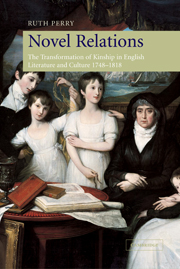Book contents
- Frontmatter
- Contents
- Acknowledgments
- Introduction
- 1 The great disinheritance
- 2 Fathers and daughters
- 3 Sister-right and the bonds of consanguinity
- 4 Brotherly love in life and literature
- 5 Privatized marriage and property relations
- 6 Sexualized marriage and property in the person
- 7 Farming fiction: Arthur Young and the problem of representation
- 8 The importance of aunts
- 9 Family feeling
- Bibliography
- Index
4 - Brotherly love in life and literature
Published online by Cambridge University Press: 22 September 2009
- Frontmatter
- Contents
- Acknowledgments
- Introduction
- 1 The great disinheritance
- 2 Fathers and daughters
- 3 Sister-right and the bonds of consanguinity
- 4 Brotherly love in life and literature
- 5 Privatized marriage and property relations
- 6 Sexualized marriage and property in the person
- 7 Farming fiction: Arthur Young and the problem of representation
- 8 The importance of aunts
- 9 Family feeling
- Bibliography
- Index
Summary
The intimate relationship between brother and sister, rather than the incest taboo, is the elementary kinship principle.
Annette B. Weiner, Inalienable Possessions, pp. 15–16.The relation of a brother and a sister, especially if they do not marry, appears to me of a very singular nature. It is a familiar and tender friendship with a female, much about our own age; an affection, perhaps softened by the secret influence of sex, but pure from any mixture of sensual desire, the sole species of Platonic love that can be indulged with truth and without danger.
Edward Gibbon, The Memoirs of the Life of Edward Gibbon, p. 2.It is a common observation, that love between brothers and sisters is rare to be met with.
Anon., Cleora: or, the Fair Inconstant (1752), p. 24.One of the main requisites of an eighteenth-century fictional hero was that he be a good brother: attentive, generous, protective, wise. Henry Tilney in Jane Austen's Northanger Abbey, about whom we know precious little except that he is a tease, qualifies as the hero of the novel by showing that he is an affectionate brother. Indeed, all the brothers in Northanger Abbey display their truest selves in relation to their sisters, as is appropriate in a novel self-conscious about the conventions and clichés of fiction. John Thorpe's boisterous, swaggering selfishness, his adolescent display, is apparent from his first insolent greeting of his mother and sisters.
- Type
- Chapter
- Information
- Novel RelationsThe Transformation of Kinship in English Literature and Culture, 1748–1818, pp. 143 - 189Publisher: Cambridge University PressPrint publication year: 2004



